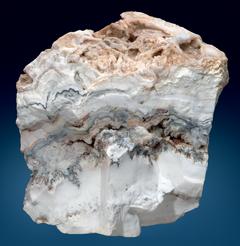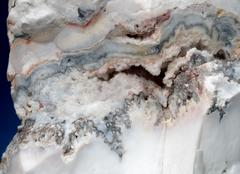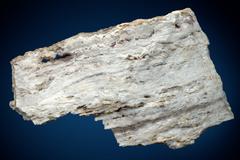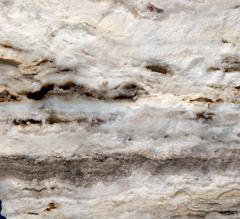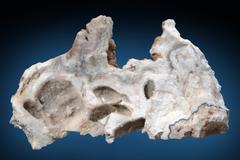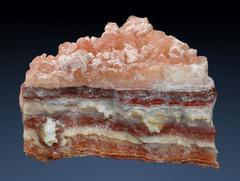Silica Sinter
Specific Properties
Occurrence
Locations and Specimen
Further Information
Specific Properties
Occurrence
Locations and Specimen
Further Information
Document status: incomplete
Under the term "silica sinter" I subsume rocks made of both cryptocrystalline quartz and other silica polymorphs that form by the precipitation of silica from watery solutions in a layered manner.
Note: The term "sinter" is normally used to describe fine-grained depositions of material at hot springs, geysers, and fumaroles - these are all superficial environments. Due to the similarity in structure and formation and due to the lack of an appropriate term, I've nevertheless decided to use that term in a more general sense that disregards the origin of the rock.
Specific Properties
Silica sinter is less homogeneous than chalcedony, agate, opal or jasper. It shows a layered structure that reflects changes in the structure and composition during precipitation. It is typically a translucent to opaque material that is white if pure but can assume any color due to embedded impurities. It may have a sponge-like look similar to that of travertine rocks.
Silica sinter may consist mainly of opal, but could as well be made mainly of very fine-grained quartz similar in structure to jasper. Small regions may assume an agate-like structure, but in most cases the banding is different from that in an agate.
Occurrence
Silica sinter generally seems to form in situations where hot silica-rich solutions get cooled very quickly. The cooling is too fast to allow the growth of large crystals or the formation of a silica gel that would be the precursor of chalcedony variants.
It can be found in hot wells in volcanic rocks and in geysers because the overheated water cools quickly at the surface. An opaline form of silica sinter found in geysers is sometimes called geyserite. Silica sinter can also be found in cracks and veins of rocks that were percolated by silica rich waters that were heated up at distant, hotter regions, for example, a nearby volcano.
Locations and Specimen
U.S.A.
The specimens shown were all found at mine dumps and in stream beds very near to the Homestake Gold Mine that is also home of myrickite, south of Clear Lake, California. Triggered by the subduction of oceanic plates (Gorda and Juan de Fuca) under the American continental plate, Northern California has been an area of volcanic activity for several million years. The subduction zone has now moved northward to Oregon and Washington, but the effects of subduction and volcanism can still be measured as the temperatures of rocks at relatively shallow depths are very high. This heat source is used for the production of electric power in geothermal power plants at The Geysers south-west of Clear Lake.
This specimen consists of different layers of silica minerals that apparently have precipitated successively from rising brines in the vein. So although one can see some banding, this is not an agate. The opaque porcelain-like base is probably an opaline material. The darker bands consist of chalcedony, and the cavities are outlined by small quartz crystals. Note how different parts of the rock show different fractures: the probably opaline base shows a smooth, conchoidal fracture, while in the upper part there are layers that have a rough fracture surface.
A close-up view of the the cavities and bands on the right side of the rock in the former picture, showing details of the banding and the cavities.
Another detail view of the same specimen. In the upper right corner, just above the cavity, you can see an agate-like banding in the slightly yellow chalcedony. A yellow vein agate from a dump of the same mine is shown on the agate page.
Another example of silica sinter from the same location. Here the layers appear to be plane on a large scale, but in a closeup view they show a ripple structure. The surface structure is very rough, like broken porcelain. The rock has a cavernous structure, and the cavities are outlined by tiny quartz crystals.
Detail view of the specimen in the former image. One can see coarse and fine grained, and more or less translucent layers. The cavities that are outlined by quartz crystals also seem to be surrounded by more translucent chalcedony with fine banding.
This piece of cavernous silica sinter shows clearly developed agate structures with a fine banding. It has been chipped from the top of the first specimen.
Myrickite is a chalcedony or jasper that has been stained red by embedded cinnabar, HgS, and that can be found as part of silica sinter. The cinnabar is of powdery consistence but cannot be washed or rubbed off. Most specimen show a patchy color. Myrickite has a conchoidal but fine grained fracture, so fractures appear dull. The deeply red parts of the rock are completely opaque.
Cinnabar is a typical mineral of low temperature hydrothermal veins that occur above zones where oceanic plates are subduced under continental plates. During the subduction water is "squeezed" out of the oceanic plate because of increasing temperatures and pressure, and these rising hot waters mobilize certain elements, like mercury, Hg, contained in the overlying continental plate that get deposited at lower temperatures near the surface.
This chert-like silica sinter apparently precipitated in several generations from rising hot waters in a vein. It contains many small irregular cavities, some of them outlined with small quartz crystals, some of them with a rough interior surface.
The specimen to the right has been found at a dump of the Homestake Gold Mine, California, south of Clear Lake. The lower image is a detail view of topmost red patch on the same specimen.
Silica sinter that precipitates in thin layers from hot waters in a hot spring is sometimes called geyserite. Often it is mainly composed of opal, like this piece of geyserite from Beaver County, Utah.
Further Information, Literature, Links
Footnotes
